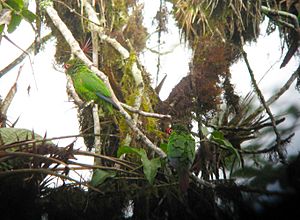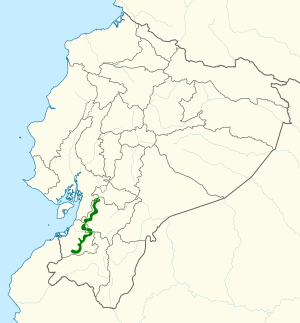El Oro parakeet facts for kids
Quick facts for kids El Oro parakeet |
|
|---|---|
 |
|
| Conservation status | |
| Scientific classification | |
 |
The El Oro parakeet (Pyrrhura orcesi) is a special type of parakeet found only in Ecuador. It's an endangered bird, which means there aren't many left in the wild. It belongs to the family of parrots called Psittacidae.
Contents
How to Spot an El Oro Parakeet
This parakeet is about 22 to 24 cm (8.7 to 9.4 in) long, which is roughly the length of a ruler. It weighs about 65 to 75 g (2.3 to 2.6 oz), like a small apple.
Most of its body is green. Adult males have a bit of red on their forehead and near their eyes. Their chest looks a bit scaly with green and grayish-brown bars. Their wings are mostly green, but some feathers are blue. The tail is a dark reddish-brown color.
Females look very similar to males, but they have less red on their forehead. Young parakeets have even less red on their heads and wings.
Where Do They Live?
The El Oro parakeet lives only on the western side of the Andes mountains in Ecuador. You can find them in the Azuay and El Oro areas. Their home is a small area, about 5 to 10 km (3 to 6 mi) wide and 100 km (60 mi) long.
They prefer to live in humid forests, usually between 600 and 1,300 m (2,000 and 4,300 ft) high up in the mountains. Sometimes, they are seen lower or higher than that.
How They Live
El Oro parakeets don't seem to travel far from their homes. They stay in the same general area.
What They Eat
These parakeets love to eat fruits and berries. Some of their favorite foods come from trees like figs (Ficus), Heliocarpus, Hieronyma, and Cecropia.
They usually look for food in groups of about 15 birds. Sometimes, bigger groups of up to 60 parakeets have been seen eating together!
Family Life: Reproduction
The breeding season for the El Oro parakeet seems to be from March to July. They build their nests in natural holes found in trees. These nests can be as high as 24 m (80 ft) off the ground. They use different types of trees, but they especially like Dacroide peruviana.
Helpers often join the breeding pair. A pair might have up to six other parakeets helping them raise their young! They also use special nest boxes provided by a nature reserve called Buenaventura.
Their Calls
The most common sound the El Oro parakeet makes is a rough, grating call, like "crreeet crreeet crreeet." They make this sound whether they are sitting on a branch or flying.
When they are perched, they might also make single "chuk" or "krrr" sounds. However, perched birds are often quiet. When a group of parakeets is together, they make a lot of noise, chattering loudly all at once!
Protecting the El Oro Parakeet
The IUCN (International Union for Conservation of Nature) first listed the El Oro parakeet as "Vulnerable." But since 2000, it has been listed as "Endangered." This is because there are very few of them left, probably fewer than 1000 adult birds.
Their forest home is getting smaller and broken up into pieces. Both the area where they live and their population are shrinking.
To help protect them, the Buenaventura Reserve was created in 1999. This reserve is managed by a group called Fundación de Conservación Jocotoco. It covers about 4,000 ha (15 sq mi) of cloudforest. The foundation also puts up nest boxes in the reserve to help the parakeets breed. About 75% of all El Oro parakeets live in or near this special reserve.
See also
 In Spanish: Cotorra de El Oro para niños
In Spanish: Cotorra de El Oro para niños


